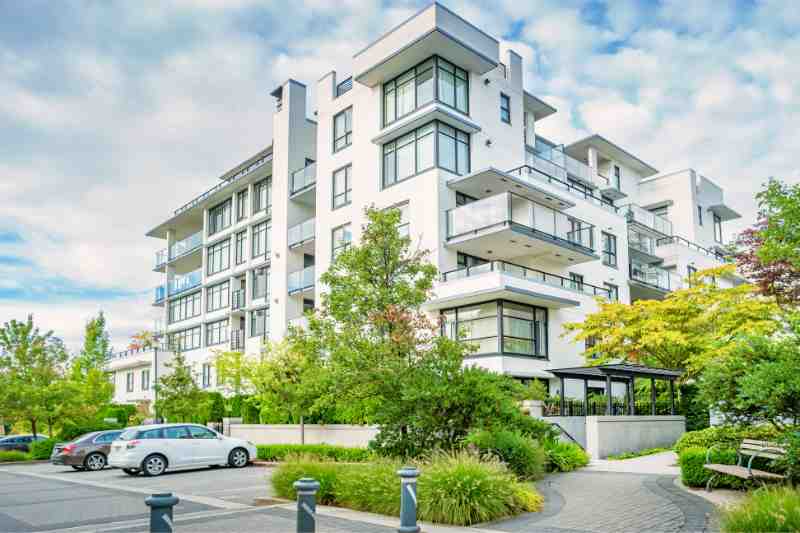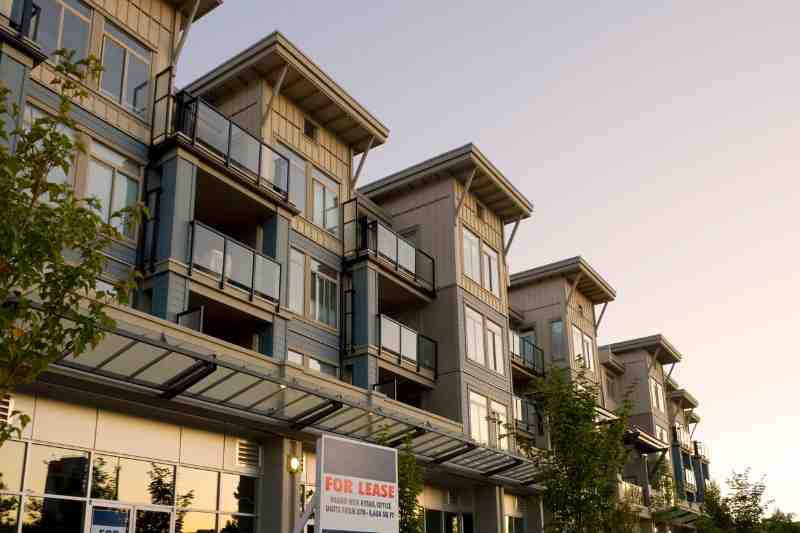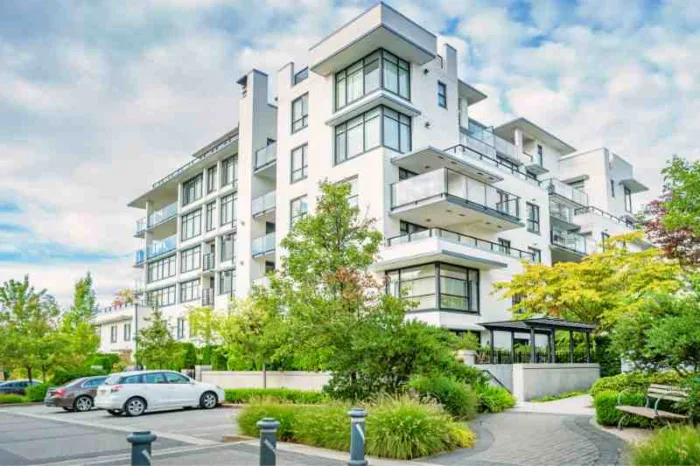Key takeaways
- Condo buildings face unique challenges because condo managers typically live onsite. So, the property you manage is also your home.
- Some of the most common challenges facing condos today include parking issues, visitor access, and security maintenance.
- Access control solutions help solve the ten most common challenges faced by condo communities.
- The best access control solution is ButterflyMX.

From mystery visitors roaming the property to the eternal struggle of managing deliveries efficiently, HOA board members and residents know the struggles of managing a condo community all too well. Luckily, implementing access control solutions like video intercoms for condos and HOAs can solve these common challenges.
Read on to uncover the top ten challenges facing condo buildings and how to solve them with access control. Then, discover the best access control solution on the market.
In this post, we cover:
Top 10 challenges faced by condo buildings
Condos offer an array of modern conveniences. However, these unique buildings come with their fair share of challenges.
These complexities only further emphasize the need for innovative solutions that tackle these issues head-on.
Here are the top ten hurdles facing condo buildings:
- Maintaining security
- Package management and theft
- Unauthorized use of communal areas
- Maintenance access
- Resident complaints
- Parking issues
- Dipping condo unit value
- Unsafe subletting practices
- Communication issues
- Visitor access
1. Maintaining security
Maintaining security at condo buildings presents a multifaceted challenge that impacts residents and condo managers alike.
One common issue revolves around unauthorized access, where residents often find themselves encountering unfamiliar faces in shared spaces. As a result, this raises valid concerns about privacy and safety.
Solution:
Access control solutions with video capabilities and heightened security system measures elevate safety and convenience for residents, visitors, and staff.
Here are a few ways access control helps maintain security at condos:
- Personalized access. Residents and authorized personnel are provided with unique access credentials, ensuring that only approved individuals gain entry to the building.
- Remote monitoring. Condo managers and board members can monitor and control access remotely, granting or denying entry as needed.
- Incident tracking. Access control systems log entry and exit data, providing an audit trail that can be crucial for investigating any security breaches or incidents.
- Real-time alerts. Access control systems send instant alerts if there’s a breach or unauthorized access attempt, enabling swift response and intervention.
2. Package management and theft
As online shopping becomes more prevalent, more and more packages are piling up in common areas. You must take action to keep deliveries organized in order to maintain a neat and tidy common area. Moreover, managing package deliveries effectively is crucial to prevent package theft.
Solution:
Access control can integrate with designated storage areas, like package rooms, to ensure packages are delivered safely and securely.
Here’s how access control mitigates package theft:
- Package management. Access control can integrate with package delivery systems, ensuring that packages are securely stored until residents retrieve them, reducing the risk of theft.
- Safer package storage. When integrated with a comprehensive access control system, package rooms safeguard parcels until residents are ready to retrieve them using their unique access credentials.
- Real-time delivery notifications. Residents receive instant notifications when packages are delivered. So, they never miss a delivery.
- Reduced exposure. By keeping packages in a controlled and locked environment, access control minimizes the visibility of packages to potential thieves or unauthorized individuals.
- Authorized retrieval. Only authorized residents with valid access credentials can retrieve their packages from the designated storage area, reducing the risk of theft.
Learn more about the ButterflyMX package room:
3. Unauthorized use of communal areas
Unauthorized use of communal areas presents a recurring challenge within condo communities. Without proper control mechanisms, these areas can be susceptible to misuse by unauthorized individuals.
Whether it’s non-residents entering the pool area, gyms, or other amenities, the breach of these communal spaces disrupts residents’ enjoyment. Further, it also raises concerns about safety and privacy.
Solution:
Access control systems have emerged as a reliable solution that empowers condo managers and HOA board members to restrict access to communal areas only to authorized residents.
Here’s how access control prevents unauthorized use of shared spaces:
- Restrict unauthorized areas. Access control can limit access to specific floors or amenities, ensuring that only residents can access certain areas.
- Personalized access credentials. Access control provides residents with personalized access credentials, ensuring that only authorized individuals can enter communal areas.
- Time-based access. Access control allows entry to communal areas during specific time windows, preventing unauthorized access during off-hours.
- Temporary access. Residents can provide temporary access codes to their guests or visitors, limiting their entry to the communal areas for the duration of their stay.
- Revoke access. If a resident’s authorization changes due to moving out or violating community rules, access control promptly revokes their access, preventing continued use of communal areas.
4. Maintenance access
Streamlining maintenance access within condos is not only a matter of operational efficiency, but it’s also a crucial element in maintaining the building’s functionality.
Coordinating access for maintenance personnel, whether it’s for repairs, inspections, or general upkeep, can be complex, particularly in larger condominiums with multiple units. So, managing maintenance access efficiently helps ensure tasks are carried out promptly and that all areas remain in top condition.
Solution:
Access control systems offer a transformative solution by enabling condo managers to grant temporary and controlled access to maintenance personnel.
Here are some ways access control streamlines entry for technicians:
- Scheduled access. Condo managers can schedule specific time slots for maintenance personnel to access units or communal areas.
- Reduced disruption. Streamlined access means maintenance activities can be completed more efficiently, reducing disruptions to residents’ daily routines.
- Emergency access. In case of urgent repairs, condo managers and HOA board members can grant immediate access to authorized maintenance personnel without delays.
- Integration with service requests. Access control can be integrated with maintenance request systems, automatically providing access to workers assigned to specific tasks.
- Enhanced communication. Access control empowers condo managers to communicate directly with maintenance personnel, ensuring clear instructions and minimizing errors.
- Maintain privacy. By providing time-limited access, access control systems honor resident privacy while enabling necessary maintenance activities.
5. Resident complaints
Resident complaints can encompass a wide range of concerns, from noise disturbances and parking issues to disputes over shared amenities and adherence to community rules.
The proximity of residents often magnifies minor inconveniences into significant grievances, leading to tensions within the community.
Solution:
Access control systems are pivotal in resolving resident complaints within condominiums by offering a secure and controlled environment.
What’s more, access control helps board members enforce community rules, resolve conflicts, and foster open communication between residents and management.
Here’s how access control helps resolve resident complaints:
- Enforce guest policies. Access control can enforce guest policies by allowing residents to provide temporary access codes for visitors, ensuring compliance with community guidelines, and preventing overstay complaints.
- Improve communication. Access control can facilitate direct communication between residents and condo managers, enabling prompt resolution of complaints through transparent and efficient communication channels.
- Rule enforcement. By maintaining access restrictions based on community rules, access control encourages compliance and helps prevent violations that could lead to resident disputes.
6. Parking issues
From limited parking spaces in densely populated condo communities to unauthorized visitor parking, parking issues are a persistent challenge at condominiums.
Additionally, issues like vehicle towing, guest parking policies, and accessibility for individuals with special needs can further complicate parking dynamics.
So, navigating these parking issues demands a combination of clear community guidelines, effective enforcement, and innovative parking management solutions to ensure equitable and orderly parking for all residents.
Solution:
Fortunately, vehicle access control systems offer a robust solution to common parking issues at condominiums.
By integrating access control with parking facilities, condos can ensure that only authorized vehicles gain entry, reducing unauthorized parking and congestion.
These systems also:
- Streamline guest and visitor parking. Streamlining visitor parking with vehicle access control empowers residents to provide temporary access for guests and service providers.
- Provide a clear and automated way to enforce community parking rules. Vehicle access control can help enforce resident-only parking zones and time restrictions, reducing disputes among residents.
As a result, by optimizing parking management, vehicle access control enhances the overall parking experience.
Moreover, vehicle access control minimizes conflicts and promotes a more organized and equitable use of parking spaces within condo communities.

7. Dipping condo unit value
The pressing issue of dipping condo unit values is a matter of significant concern for condo owners. In some cases, poorly managed condo buildings directly contribute to reduced unit values.
Solution:
Luckily, condo owners, investors, and condo managers can adapt to these changes by making property improvements, like investing in access control, to mitigate the impact of dipping condo unit values.
By enhancing security and providing a sense of safety to residents, access control makes condominiums more attractive to potential buyers and tenants, helping to stabilize or even increase property values.
Access control also contributes to efficient property management by:
- Boosting security. Access control systems bolster security, making condos a more attractive and safer place to live.
- Improved value. Access control technology can enhance the overall perception of the condo, potentially leading to higher appraisals and demand from buyers and tenants.
- Log data for maintenance. Access control systems provide data on entry and exit. So, this helps condo managers schedule and plan maintenance for upkeep. As a result, this improves the overall aesthetic, appeal, and property value.
- Community compliance. Access control can help enforce community rules and regulations, ensuring that residents adhere to guidelines that maintain the property’s appeal.
- Marketability. Access control is a unique selling point when marketing condo units, especially in competitive markets, potentially helping units sell or rent faster at a higher price.
8. Unsafe subletting practices
Unsafe subletting practices at condominiums can jeopardize the security, harmony, and community reputation.
In extreme cases, condo units are subleased to individuals without proper vetting or oversight, or without the knowledge or consent of the condo association.
This can lead to a range of problems like:
- Unauthorized occupants and overcrowding.
- Increased wear and tear on common areas.
- Potential security risks.
- Parking concerns.
Solution:
Access control systems have emerged as an invaluable tool for addressing unsafe subletting practices within condominiums.
By integrating access control, condo managers can:
- Enforce strict regulations on who can enter and occupy condo units.
- Provide temporary access credentials to short-term tenants that expire at the end of the lease term.
- Maintain a record of occupants, enhancing security and accountability.
- Limit the number of occupants in a unit, preventing overcrowding and associated safety risks.
9. Communication issues
Communication issues often arise due to the complex web of relationships and shared responsibilities among residents, condo management, and condo boards.
Common communication challenges include:
- Residents feeling left out of decision-making processes.
- Insufficiently clear or inconsistent messaging from management.
- A lack of effective channels for expressing concerns or feedback.
Solution:
Access control systems are crucial in addressing communication issues within condo communities.
With this in mind, access control systems serve as a central hub for conveying important information like:
- Important announcements
- Updates to community rules and guidelines
- Community events
When paired with condo management software, access control systems can send real-time notifications to residents. So, condo managers can ensure that crucial information reaches residents promptly.
Additionally, access control can facilitate two-way communication by providing residents with a direct channel to contact condo management or HOA boards with their concerns or questions.
As a result, by offering clear and efficient communication tools, access control systems help bridge the gap between residents and management, enhancing transparency, trust, and a sense of community within condominiums.

10. Visitor access
Effectively managing visitor access at condos is a crucial aspect of security and community living.
Moreover, managing and controlling the entry of individuals who are not residents or authorized personnel is a valuable aspect of visitor management.
Solution:
Innovations like digital visitor management systems and video intercoms empower residents to verify and authorize guests remotely.
Striking the right balance between security and convenience is key, as efficient visitor access contributes to a welcoming and secure living environment within condo communities.
Here’s how access control empowers secure condo visitor access for parking and general visits:
- Visitor management. Access control allows for controlled visitor entry, preventing unknown visitors from freely roaming common areas.
- Give temporary access. Temporary access codes or credentials can be provided to guests or service providers that automatically expire after a set period. So, non-residents won’t be able to use credentials after a certain time period.
- Track visitor logs. Access control systems maintain visitor logs, offering an audit trail of who entered and when for security and monitoring.
- Efficient processing. Streamlined visitor access procedures save time and minimize inconvenience for both residents and their guests.
The best access control solution for condo buildings
ButterflyMX is the best solution for making property access simple at HOAs and condos.
ButterflyMX offers a suite of access control solutions for HOAs and condos like:
- Video intercom. The ButterflyMX video intercom empowers residents to launch two-way video calls with visitors. What’s more, it takes time- and- date-stamped photos of all entry events.
- Elevator controls. ButterflyMX empowers you to enable self-guided tours and limit access to certain floors with your key-fobbed elevator.
- Package room. A holistic package room solution keeps packages secure until residents are able to retrieve them. Additionally, the ButterflyMX package room sends real-time alerts once packages are delivered.
- Vehicle access control. Enable seamless hands-free access to every vehicle at your property with ButterflyMX vehicle readers and windshield tags.
- Smart lock integrations. ButterflyMX integrates with over 80 smart locks, so you can open doors with the ButterflyMX mobile app.
- Delivery passes. Send single-use delivery PINS to delivery couriers so that they can drop off parcels securely without residents needing to be home.
- Visitor Passes. Temporary or single-use Visitor Passes grant remote property access to visitors, service providers like dog walkers and house cleaners, and technicians securely.







